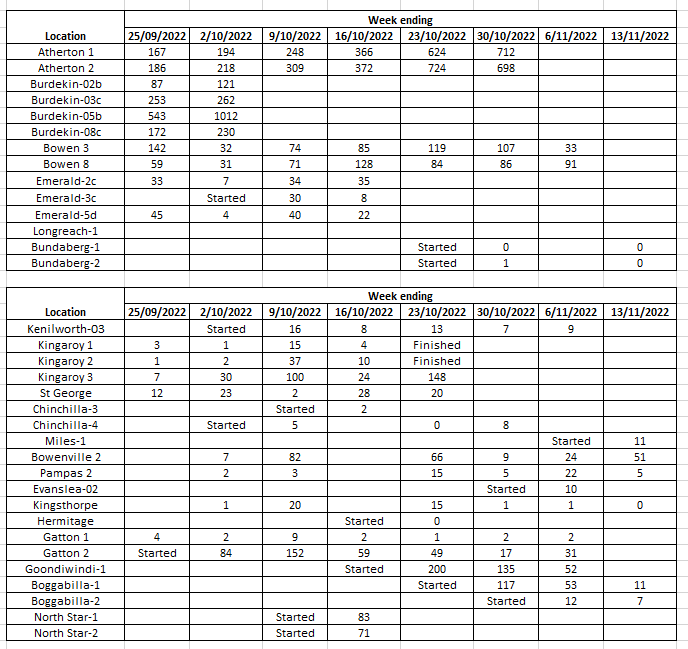Fall armyworm (FAW) moth catches have increased significantly in some regions over the past few weeks (see trapping counts below).
It is unclear whether this increase in trap catches is indicative of migration events (perhaps associated with the recent storm activity) or increasing night temperatures that allow for greater movement of moths that may have emerged locally.
Very low densities of FAW have already been observed in corn and forage sorghum crops in the western Downs, eastern Downs, McIntyre and Lockyer Valley. Infestations reported are largely patchy in distribution, and egg masses have been difficult to find.
This week, with the warmer conditions, there is evidence of increasing FAW activity with more egg masses and an increased density of small larvae across fields.
If you are growing corn or sorghum (for grain or silage), or millet, then it is imperative that you monitor closely for FAW. Here are some key considerations for this early part of the season:
1. Not all caterpillars in corn, sorghum and millet will be FAW
High native armyworm and helicoverpa pressure in winter cereals is likely to result in infestations of these species in corn, sorghum and millet too. This highlights the importance of actually sighting larvae, rather than assuming that all damage in these crops means you have a FAW infestation.
Distinguishing FAW larvae from those of common armyworm and helicoverpa is possible, particularly with experience and with larger larvae. Resources to help you correctly identify each species are available in the Beatsheet’s FAW section (https://thebeatsheet.com.au/key-pests/fall-armyworm/faw-identification/).
2. FAW eggs can be difficult to find – but easy to recognise
FAW eggs are typically deposited in clusters (with or without scale covering) on the underside of lower leaves of small plants (<V4). If you are looking for eggs, focus on the cotyledon and the first and second expanded leaf, and towards the base of the leaf.
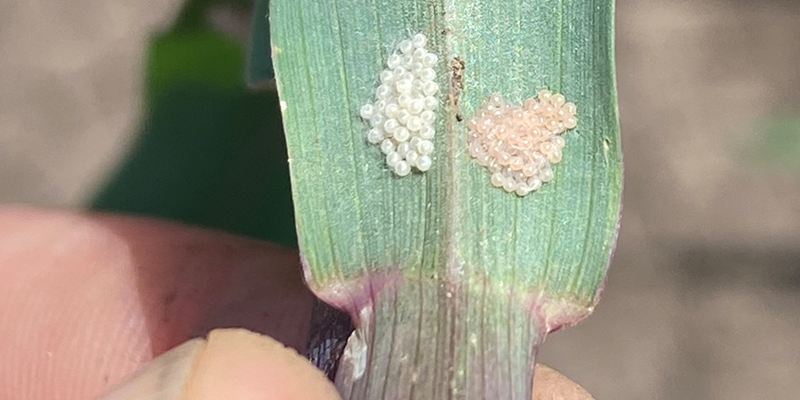
Egg masses are often laid on the underside towards the base of lower leaves.
If you can’t find egg masses, you might see signs that there have been egg masses that have hatched and the larvae dispersed. It may take as little as 3-5 days for an egg mass to hatch and larvae to move from exposed feeding site. Larvae consume the egg shell when they hatch, so there will be nothing of the egg mass left to see except signs of early instar feeding. If larvae have dispersed very quickly from the egg mass site, then there may be no sign of the egg mass at all.
Second and third instar larvae, and the windowing (feeding damage) they cause is easier to see on newly expanded and furled leaves in the whorl.
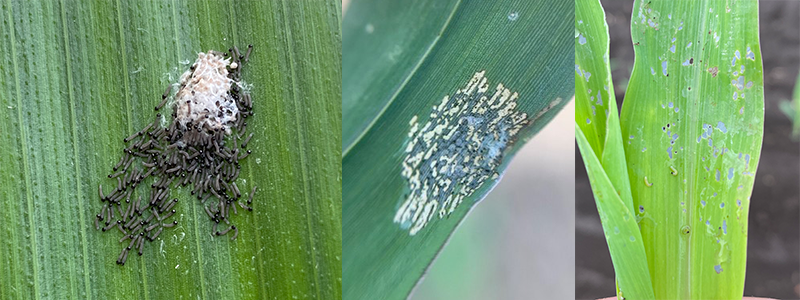
Left: hatching egg mass showing the first instar larvae starting to disperse
Middle: evidence of feeding around the site of an egg mass
Right: second instar larvae and typical windowing.
3. There are other things to look for than just FAW eggs and larvae
There can be a surprising number of natural enemies present when monitoring for FAW. While predators do not leave much evidence behind, visual signs of parasitoid and pathogen activity can be quite common in some fields.
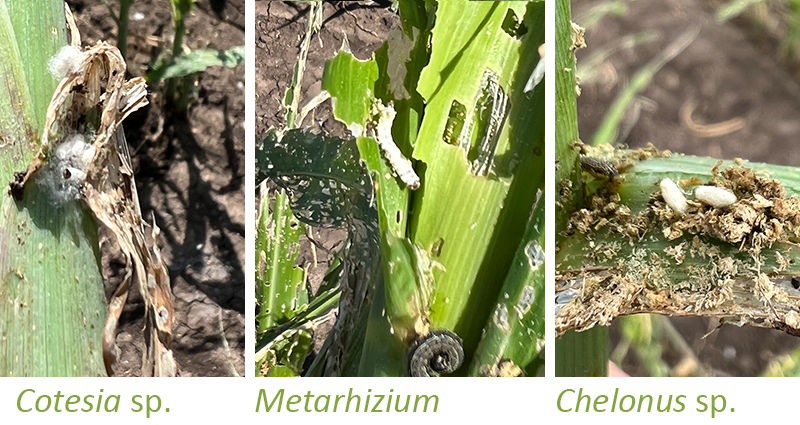
Larval parasitoid cocoons (left). FAW larva turns white after being infected with, and killed by, a fungal pathogen (centre). Egg parasitoid pupae (right), where the wasp larvae emerge from small FAW larvae (killing them in the process) and pupate.
4. Just counting plants with feeding damage is not a reliable way to determine the extent of an infestation
A relatively small proportion of larvae that hatch will survive and establish in the whorl of a plant. Of course, the higher the pressure/number the higher the number establishing.
There is no substitute for pulling plants apart to assess an infestation. Dissecting the plant provides information on the number of larvae per plant (and what species), and the size of the larvae – both very important bits of information for making decisions about the management of the infestation.
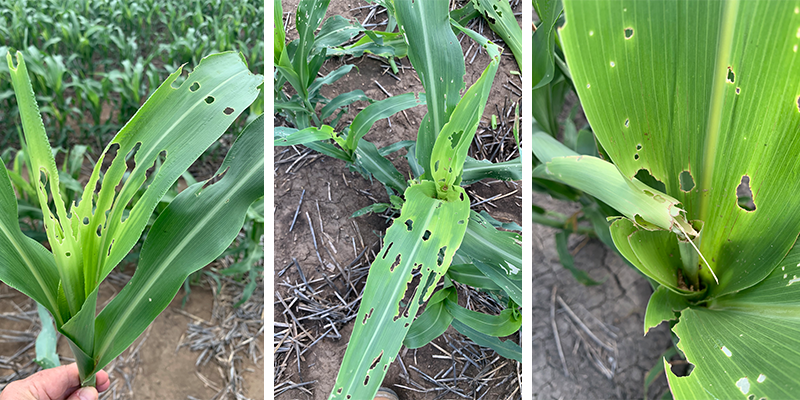
Plant damage typical of helicoverpa or common armyworm feeding in sorghum (left). FAW damage typically includes severe and persistent damage to leaves as they expand and/or complete severing of the unfurled leaves in the whorl (centre & right).
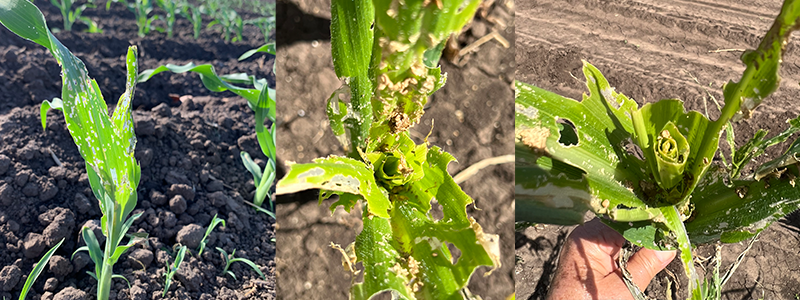
Left: windowing is evidence of early instar feeding activity, but not how many larvae may have established in the whorl and likely to cause ongoing damage. Middle: a plant with recent damage from a large FAW larva in the whorl, but the larva was no longer present- likely finished development and left the plant to pupate. Right: damage to the expanded leaves, but not the whorl shows that the larva/e that were causing damage are no longer in the whorl. Contrast that with the image on the far right where the whorl is severely damaged with no new growth – indicative of a large, actively feeding FAW larva still being in situ.
The size of the larvae that you find will inform your understanding of the risk of loss in the crop.
If only large (4th – 5th instar) larvae are found, then the amount of feeding damage is at its maximum, and these larvae may complete development before a treatment can be applied. The survival of larger larvae is also likely to be high, compared with the survival of larvae 1st – 3rd instar. If smaller larvae are found, or a mixture of eggs and larvae, then the risk of loss is higher because damage will continue to occur as these eggs and larvae develop.
5. A zero-tolerance policy on FAW is not necessary – but vigilance is vital
Whilst we don’t yet have estimates of FAW thresholds, it is clear from the first year’s trials on FAW crop loss that:
- The longer an infestation of FAW persists in a crop, the greater the impact on yield. In other words, if you have one significant egg lay and then no more, the potential loss will be lower than if you have continuous egg lays and persistent defoliation through the vegetative stages.
- Establishing plants (smaller than V4) are very vulnerable to being killed or growth severely stunted if they are exposed to infestations of medium – large larvae.
- Heavily damaged plants are less attractive to female moths looking for somewhere to lay eggs (oviposition)
- Reproductive crops (post tassel) are less attractive to female moths as oviposition sites.
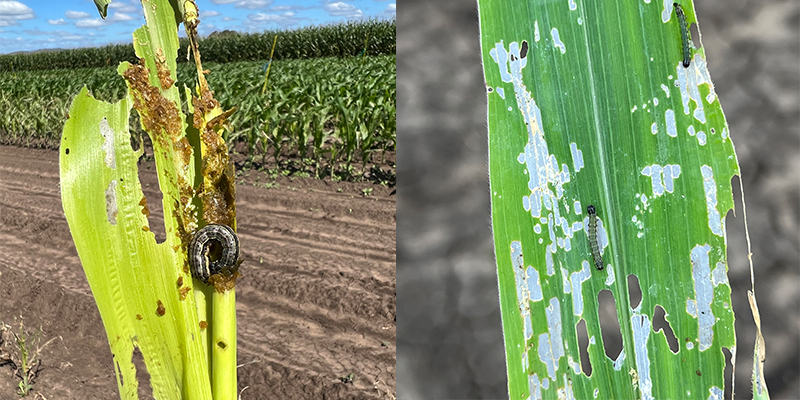
Left: a large FAW close to pupation. It is causing the maximum possible damage, but not for much longer.
Right: medium FAW larvae that are not yet causing maximum damage and will continue to feed for another 2 weeks or so.
6. Predict future larval development using DARABUG
The warmer the seasonal conditions, the faster FAW eggs, larvae and pupae develop. How long the larvae you find in your crops will continue to feed can be determined by running your scenario in DARABUG. Try running DARABUG to see how the rate of development changes through spring – summer in your part of the world (just put your GPS location into the tool). Running a range of scenarios is a useful exercise for helping you develop ‘rules of thumb’ on development rates for FAW and other species (e.g. helicoverpa, common armyworm etc).
Learn more about DARABUG at https://thebeatsheet.com.au/darabug/

